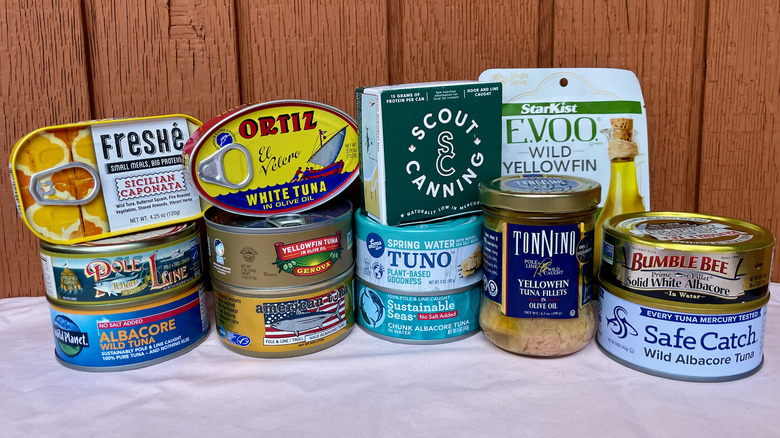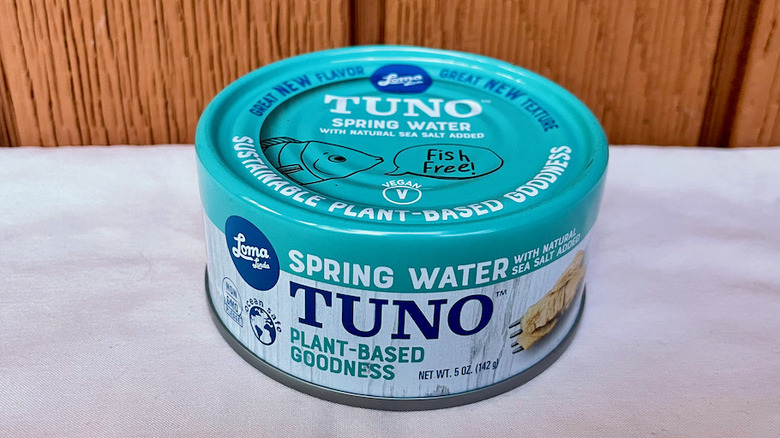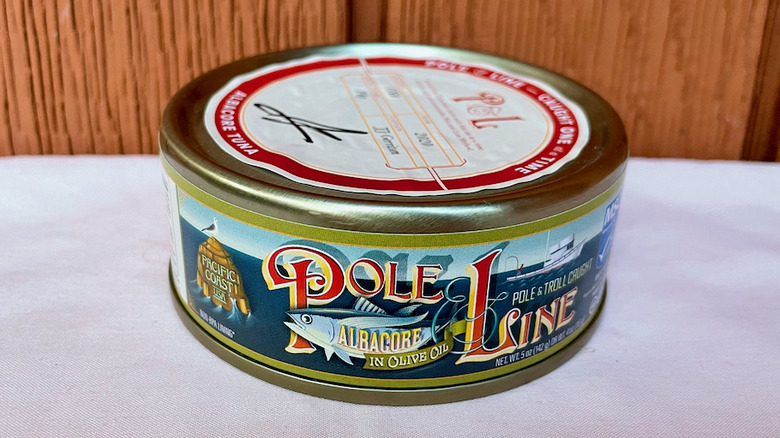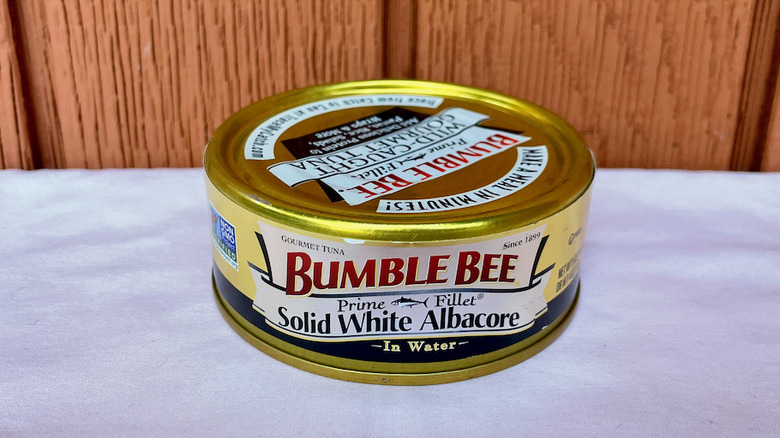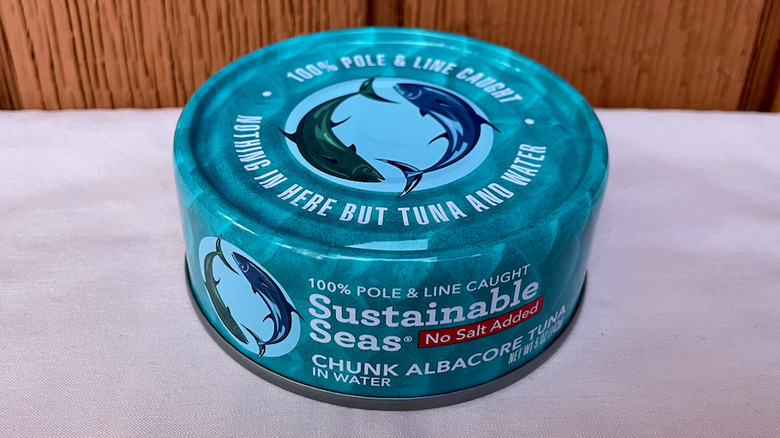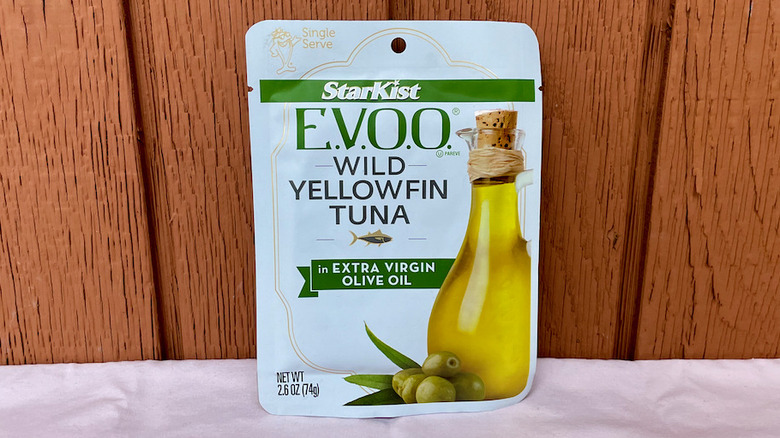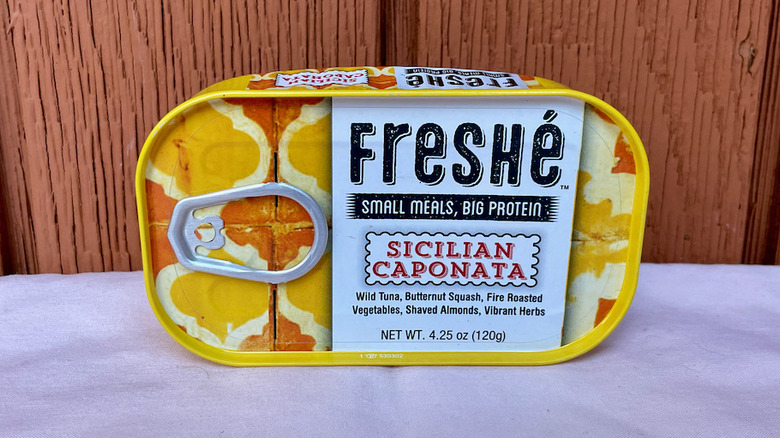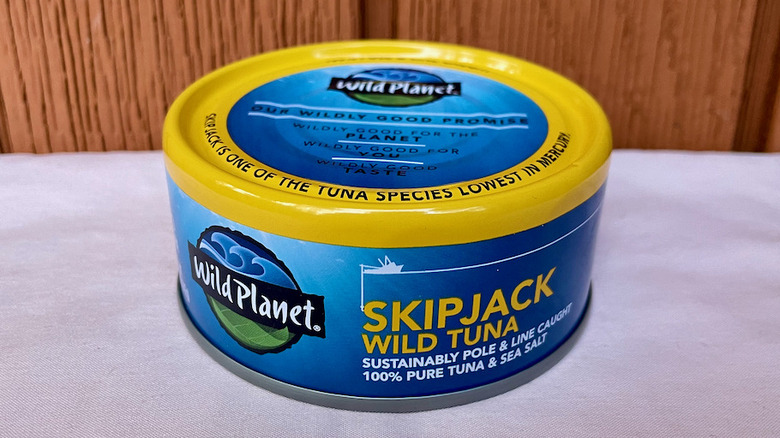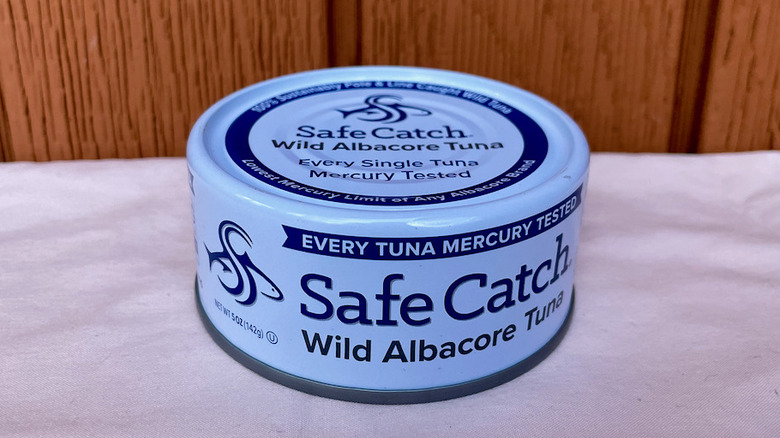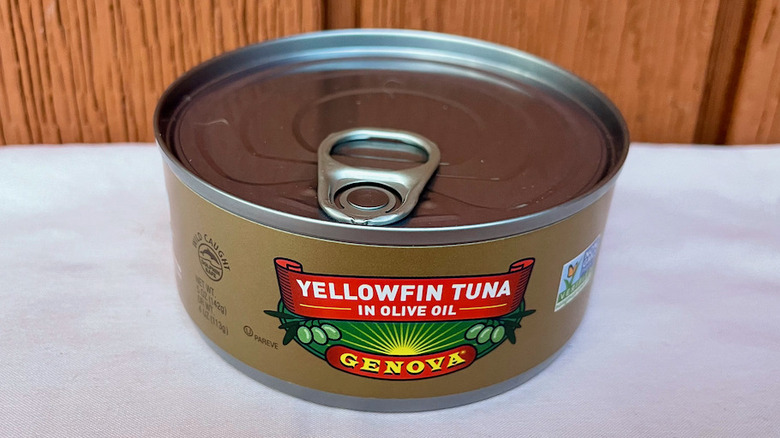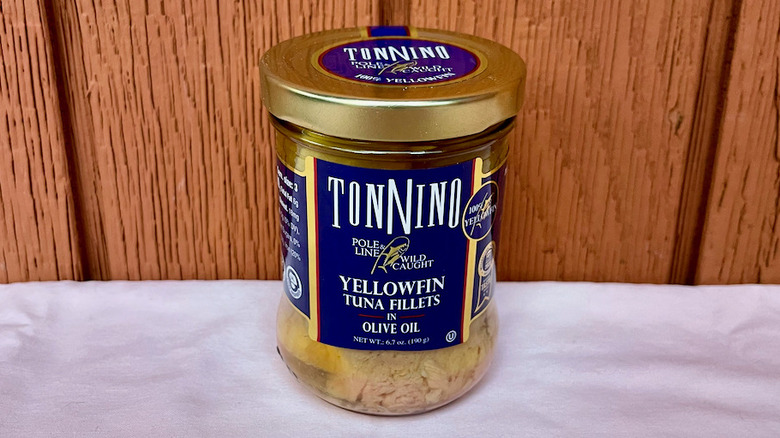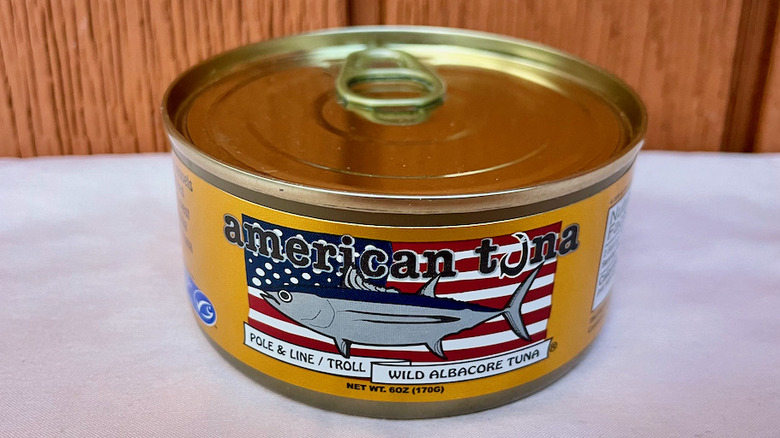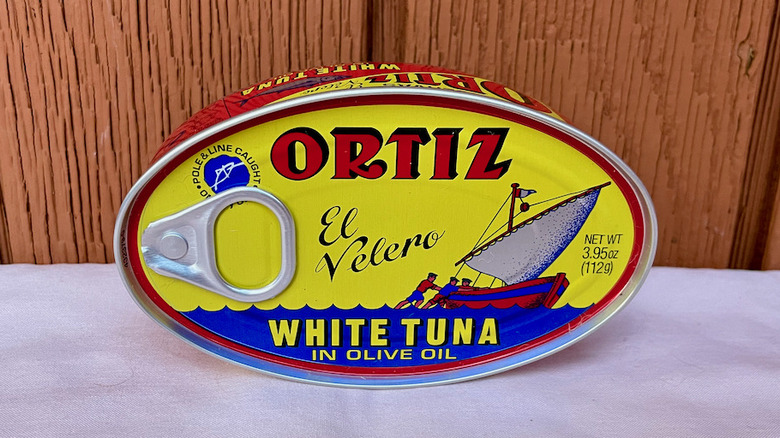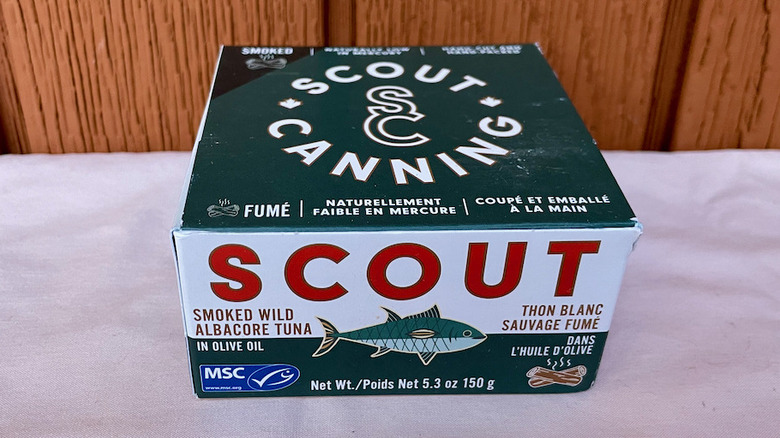The Best Tuna Brands, Ranked
We may receive a commission on purchases made from links.
Tuna is something that many of us buy based on price alone. We're just going to mix it with mayonnaise and turn it into tuna salad anyway, so why spend extra on it? Most cheap tuna tastes like basically nothing, anyway.
While there's a time and place for inexpensive tuna, if you've never sampled the ritzier stuff, you're missing out. It's hard to believe that the tuna from artisanal producers comes from the same fish as the regular stuff — it just has so much more flavor, and the texture is usually better too. Good oil-packed tuna will elevate your tuna melt game. In addition to the culinary benefits, there are often ecological advantages to spending more on tuna. Many of the premium brands on this list are pole and line caught, which can reduce the harm to other species caused by fishing (via the Monterey Bay Aquarium).
We've rounded up some of the nicest brands of tuna you can buy and tasted them all to see which of the fancy fish brands comes out on top. Keep on reading to find out which types of tuna you should splurge on.
13. Tuno
We know, it's shocking: the one vegan tuna substitute on this list is at the bottom. But plant-based meat substitutes have come a long way in the last few years, so we wanted to give Tuno (get it?) a shot. And we can imagine someone enjoying this product — for people who don't eat fish, it's not entirely without merit. But in a head-to-head shootout, it was hard for the Tuno to compete with real tuna.
Tuno is primarily composed of chunks of textured soy protein packed in water. Additions like yeast extract and seaweed powder lend umami and some oceanic brininess. When you open the can, you get hit with a potent seafood smell, but it's not much like tuna. Weirdly, it smells fishier than tuna, more like sardines or anchovies. Texturally, it's fairly soft and moist compared with most of the traditional tunas we sampled. It tastes basically like it smells, with a strong seaweed/ocean/brine flavor, although it also has some unexpected sweetness.
Overall, we weren't crazy about this product when eaten straight out of the can. But, of course, people rarely eat any tinned tuna this way. Tuno sells varieties seasoned with Sriracha or lemon pepper that would probably be tastier. The plain version would still make for an enjoyable vegan "seafood salad," even if it isn't super compelling on its own.
12. Pole & Line
The most important thing about Pole & Line brand tuna is right there in the name: It's caught by hand with fishing poles. The photos on the company's site show fishermen catching tuna much in the same way you would angle for fish if you went on a family fishing trip. Pole & Line claims that this approach allows its fishermen to catch tuna without the accidental harvest of other types of fish that can be a byproduct of other fishing methods. While we found the pole-caught aspect of this tuna appealing in theory, it wasn't our favorite product taste-wise. Also, many brands on this list use similar fishing methods, so being pole-caught alone isn't enough to buy this product.
Our main complaint about Pole & Line tuna, at least the can we sampled, was that the tuna was broken into a bunch of tiny pieces. This made its texture fairly unsatisfying compared to other brands at similar premium price points (we paid $5.69 for a 5-ounce can) that packed whole pieces of tuna into their cans rather than small flakes. The small pieces did have one major advantage, however: Since they were packed in olive oil, they felt super moist. Tuna basically gets cooked well-done as part of the canning process, so it's hard to make it not dry out a little bit, but that was not a problem with Pole & Line.
11. Bumble Bee Prime Fillet
Since we were focusing on premium-quality tunas for this taste test, we mostly stayed away from the common mass-market brands, but clearly, the big names want a piece of the fancy tuna market because both Bumble Bee and Starkist now sell several types of premium tuna. We tried Bumble Bee Prime Fillet solid white albacore in water. Strangely, this product isn't listed on the company's site, but you can find it on Amazon.
At around $2.50 a can at our local grocery store, this Bumble Bee product was slightly over twice as expensive as the company's standard tuna. Price-wise, that puts it roughly in the middle between standard commodity tuna and artisanal brands. We'd say the quality is roughly in the middle as well. It's definitely better than regular Bumble Bee; there's a whole chunk of albacore in the can, although there are also more small flakes of fish than in the pricier brands. The fish is also a bit mushy, though it has a pleasant, mild flavor. This would be a decent pick if you don't want bottom-shelf tuna, but also can't justify spending $5-$10 a can for the ritzy stuff.
As for sustainability, this can has the dolphin-safe label on it. That's definitely a good thing, but it's not a guarantee, as the fishing industry still kills a few hundred dolphins every year, per Newsweek.
10. Sustainable Seas
Sustainable Seas is another pole and line-caught brand, so it's doing well on the sustainability front. We preferred this brand's chunk albacore tuna in water to Pole & Line's tuna, and it was also cheaper at $4 a can. We happened to taste the no salt added version of this product, but we'd recommend getting the salted one unless you need to watch your sodium intake for medical reasons. The lack of seasoning left this tuna somewhat bland, though it still had more fish flavor than the Bumble Bee.
In terms of consistency, the can was a mixture of large, meaty chunks of tuna with some small flakes. As we conducted this taste test, we noticed that we tended to prefer the texture of the tunas packed either in oil or by themselves to the ones packed in water. Water-packed tuna tastes and feels boiled rather than poached and has a less luxurious mouthfeel than oil-packed fish. That said, Sustainable Seas is still leagues ahead of dollar-a-can grocery store tuna at a fairly affordable price for fish of this quality. It might be a little better for the environment, too, which feels worth the $4 price tag.
9. StarKist
StarKist is another grocery store brand putting out some premium products now. We thought StarKist did a better job than Bumble Bee at making its fancy option, in this case, StarKist E.V.O.O. yellowfin tuna packed in olive oil, feel like a luxury product. At $1.92 for a 2.6-ounce pouch, it's significantly more expensive per ounce than the Bumble Bee, so perhaps you get what you pay.
This tuna came in small pieces, perhaps as a side effect of being packed in a pouch rather than a can. However, this didn't have a deleterious effect on the texture like it did in some of the other tunas. The fish was soft and tender but didn't go over the edge into mushy territory. The flavor was great, though it didn't taste all that much like tuna. The fruity notes of high-quality olive oil dominated our palates. This wasn't a bad thing, but if you want your tuna to taste mostly like fish, this wouldn't be the product for you. Just like the Bumble Bee, this tuna has a dolphin-safe label, but beyond that, this product doesn't make any specific sustainability claims.
8. Freshé
This is the most unique tuna brand we tried for this ranking. Instead of just selling tinned fish, Freshé creates meals in a can. It sells four varieties of tuna meals: Aztec Ensalada, Provence Nicoise, Sicilian Caponata, and Thai Sriracha. Each flavor combines canned fish with a mixture of vegetables and seasonings inspired by the region it's named after, like butternut squash, herbs, and almonds in the Sicilian Caponata or peppers, red beans, and corn in the Aztec Ensalada.
The quality of the vegetables and seasonings in these cans is impressive. They don't taste as if they came from a tin, and they really do make for great little office lunches when paired with some fancy crackers. The flavor combinations are well-thought-out; the Thai variety was the only one we thought was a little weird.
The reason Freshé isn't higher on this list is that with all the extra components, it's hard to assess the quality of the fish itself. It doesn't seem like bad tuna — it has a nice meaty texture that stands up to the other ingredients — but you can't really taste the fish very much. However, if you want portable, easy, protein-packed snacks with serious flavor, Freshé products won't disappoint.
7. Wild Planet
Wild Planet's branding focuses on environmental stewardship. The fish is pole and line-caught, and the company tries to harvest fish populations with the green label from the Monterey Bay Aquarium Seafood Watch, which is an indicator of sustainability. But how does it taste?
We sampled Wild Planet's skipjack tuna with salt. The company also cans albacore tuna and a variety of pre-seasoned fish products and canned meals similar to Freshé's lineup. The tuna is packaged in the can without any oil or water, so you get the pure taste of the fish. Like most canned tuna, the texture is slightly dry, though not unpleasantly. We were impressed with the flavor of the skipjack, as it tasted more like freshly-cooked well-done tuna than a canned product. The fish came in one big filet, and we appreciated the lack of tuna confetti in the can.
We also tried some of the company's canned tuna salad meals, which were quite good. They didn't have quite the flavor intensity of the Freshé ones, but that meant you could taste the tuna more. They also seemed surprisingly fresh for something straight out of a can.
6. Safe Catch
While a lot of the marketing we see from the premium tuna brands focuses on whether their products are safe for dolphins or the planet, it's important to know whether the tuna is safe for consumers too. Mercury contamination in tuna is a real concern, as high levels of mercury can lead to health issues. Pregnant people, in particular, need to be wary of consuming mercury. Safe Catch says it tests every fish it catches and has an upper threshold for mercury levels that's 10 times lower than the FDA's regulations. Because of this, the company says its tuna is safe for pregnant people and small children who must be careful to avoid mercury exposure. For those people, as well as for people who consume canned tuna very regularly and are afraid of all the mercury they may be ingesting because of it, Safe Catch is a natural choice.
We sampled Safe Catch's albacore tuna with salt. Like the Wild Planet, the tuna is canned with no extra liquid and sits in its own natural juices. It's a little dryer than the Wild Planet and tastes less like fresh tuna. Instead, it has a salty, savory, intense, and satisfying flavor. We were happy that the low-mercury brand was also no slouch in the flavor department.
5. Genova
Tuna packed in a can by itself develops a nice meaty texture, but it can end up pretty dry. Large chunks of tuna packed in olive oil, like the Genova yellowtail tuna we sampled, end up soft and silky in comparison, at least if they're done right. Genova does it right. The fish in the can is moist and feels just barely cooked through, not totally cooked to death like some other canned tuna. Genova is also the best value of the top-tier tunas on this list. It was actually a few cents less per can than the Bumble Bee Prime Fillet, and we thought it was much better. Judging by the grocery stores in our area, Genova is also more widely available than some of the niche brands.
The one thing Genova didn't have that the (more expensive) brands higher on this list did was strong tuna flavor. The fish tasted quite mild, which some people may prefer to more assertively fishy tunas. It depends on what you like, but for us, we gravitated towards the brands with a little bit more tuna flavor.
4. Tonnino
Despite the Italian-sounding name, Tonnino tuna is actually from Puntarenas, Costa Rica. It's pole and line caught, so it checks off the sustainability box. Tonnino comes packaged in little glass jars, which feel a little classier than metal tins. It needs to be good to justify its price: over $9 for a 6.7-ounce jar of yellowfin filets in olive oil. It delivers.
Tonnino's fish tastes more savory and seasoned than Genova's. It has a nice soft oil-poached texture, though it's not quite as smooth as Genova yellowtail. The olive oil it's packed in is more flavorful than the one Genova uses — it has a nice grassy flavor, like a good-quality oil you'd want to cook with. The filets of fish are compact and well-defined, with absolutely no small flakes of tuna muddying up the olive oil. We probably wouldn't buy Tonnino as our everyday tuna, but it would be a fun splurge for a dish where you really need nice yellowtail.
3. American Tuna
Now we move from one very expensive tuna brand to an even more expensive one: American Tuna, which we bought for $10 for a 5-ounce can. At such an exorbitant price, we were prepared to judge this brand harshly, but we can't lie: It's really, really nice fish.
If Genova is the tuna for people who aren't that into fish, American Tuna is for the opposite niche. It's fishy in the best way possible. This pole/troll-caught American wild albacore is canned dry with just a little sea salt (the company also makes an unsalted version and flavored tuna as well).
This tuna is all about a big, meaty, savory flavor. Despite the lack of olive oil, it also feels decadently fatty, with an unctuous mouthfeel. It was the least dry of any of the tunas that were packed with no extra liquid. The American Tuna albacore was fairly moist and didn't seem overcooked. We loved it; we just still wish it wasn't quite so expensive.
2. Ortiz
Ortiz is the only Spanish brand on this list. The company packages a different kind of tuna from any other brand we sampled: white tuna, otherwise known as longfin. The white tuna is caught with fishing rods during a fairly short seasonal window: July through October. The company makes various products, but we sampled its flagship white tuna in olive oil.
Like the other oil-packed tunas, the Ortiz had a nice soft, silky texture. It was both softer and more flavorful than the Tonnino. It had some of the fresh tuna flavors we liked in the Wild Planet but with a superior mouthfeel. The olive oil in the can was also super high-quality, with grassy, peppery, and herbal flavor notes. With this product, you definitely don't want to waste any of that oil — it would make for a great salad dressing or even a dip for bread. Ortiz has been around since 1891, and we can see why the company has persisted so long. Its products are hard to beat, but for us, one tuna edged out Ortiz.
1. Scout
It feels unfair to compare Scout with tuna brands you can buy in the grocery store. It's a chef-driven company founded by Charlotte Langley, who has over a decade of experience with cooking gourmet seafood. Scout's Albacore tuna is harvested in the Pacific Northwest. Price-wise, it's up there with American Tuna, but Scout makes really special products.
We sampled Scout's smoked albacore in olive oil, which really knocked our socks off. We legitimately had no idea canned tuna could taste this good. In addition to the strong flavor of the fish itself, the smoke added another deeper layer of savoriness. The smoked fish is seasoned with a mix of salt and sugar, making it taste like Texas barbecue or smoky bacon. You could crack open a can of this and serve it with crackers as an appetizer at a fancy dinner party — it's that good. Mixing it into a tuna salad or something like that would feel almost sacrilegious.
